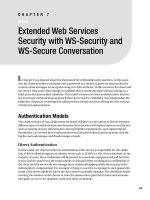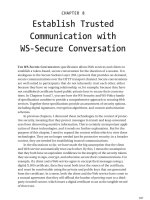Establish Trusted Communication with WS-Secure Conversation
Bạn đang xem bản rút gọn của tài liệu. Xem và tải ngay bản đầy đủ của tài liệu tại đây (258.2 KB, 28 trang )
187
CHAPTER 8
Establish Trusted
Communication with
WS-Secure Conversation
T
HE
WS-S
ECURE
C
ONVERSATION
specification allows Web services and clients to
establish a token-based, secure conversation for the duration of a session. It is
analogous to the Secure Sockets Layer (SSL) protocol that provides on-demand,
secure communications over the HTTP transport channel. Secure conversations
are well suited to participants that do not inherently trust each other, either
because they have no ongoing relationship, or, for example, because they have
not established certificate-based public-private keys to secure their conversa-
tions. In Chapters 6 and 7, you saw how the WS-Security and WS-Policy family
of specifications combine to provide a comprehensive approach to securing Web
services. Together these specifications provide an assortment of security options,
including digital signatures, encryption algorithms, and custom authorization
schemes.
In previous chapters, I discussed these technologies in the context of protec-
tive security, meaning that they protect messages in transit and keep unwanted
eyes from discovering sensitive information. This is certainly an important appli-
cation of these technologies, and it needs no further explanation. But for the
purpose of this chapter, I need to expand the context within which to view these
technologies. They are no longer needed just for protective security; in a broader
context, they are needed for establishing trusted communications.
In the discussions so far, we have made the big assumption that the client
and Web service automatically trust each other. By this, I mean the assumption
that they both have an equivalent confidence in the integrity of the security tokens
they are using to sign, encrypt, and otherwise secure their communications. For
example, if a client and a Web service agree to encrypt their messages using a
digital X.509 certificate, then they must both trust the source of the certificate,
and must be comfortable using the private and public keys that are generated
from the certificate. In a sense, both the client and the Web service have come to
a mutual agreement that they will offload the burden of proving trust to a third-
party (trusted!) source, which issues a digital certificate to act as the tangible record
of that trust.
3901c08_final.qxd 6/30/04 3:18 PM Page 187
Chapter 8
188
Of course, the issue is more complex than this. When it comes to certificates,
for many of us they are a necessary requirement for trusted communication. As
a client, I may have all the trust in the world for a service provider, but I still need
to use a digital certificate for the mechanics of signing and encrypting shared mes-
sages. I happen to be comfortable with digital certificates for most communication
requirements because it represents certified trust. However, other client-service
communications may be just as well off using a simpler UsernameToken security
token, which is based on a simple username-password combination that gets
hashed during transit. Luckily, the WSE implementation of the WS-Security
specification is flexible, and you have a choice of security token types to use for
conducting trusted communication.
The point is that your preferred security tokens and your preferred hashing
and encryption algorithms are simply a means to a bigger goal of establishing
trusted communication, otherwise known in the Web services world as secure
conversation. There is no single correct choice of technologies that you should
always use. Instead, you need to be using those technologies that are appropriate
for establishing a trusted, secure conversation between a given client and Web
service. The rules can change depending on who is doing the communicating.
This chapter focuses on how you establish session-oriented, trusted communi-
cations using the WS-Secure Conversation specification. The great thing about the
WS-Specifications is that many of the concepts complement each other and build
on each other. The understanding that you now have about WS-Security and WS-
Policy will translate directly into the concepts behind WS-Secure Conversation.
By the end of this chapter, you will have a good understanding of what consti-
tutes secure conversation, and a broader appreciation for the usefulness of the
WS-Security family of specifications.
Overview of Secure Conversation
The WS-Secure Conversation (and WS-Trust) specifications provide the means
for a client and a service to establish an optimized secure communication chan-
nel for a limited duration of time. Secure conversation is based on security tokens
that are procured by a service token provider. This process involves an initial
amount of overhead, but once the channel is established, the client and service
exchange a lightweight, signed security context token, which optimizes message
delivery times compared with using regular security tokens. The security context
token enables the same signing and encryption features that you are used to with
regular security tokens.
Secure conversation is analogous to communications over the HTTPS proto-
col. HTTPS establishes a secure channel for the duration of a session, and ceases
to be in effect once that session is over. The classic example is an eCommerce
3901c08_final.qxd 6/30/04 3:18 PM Page 188
Establish Trusted Communication with WS-Secure Conversation
189
transaction, in which you browse a catalog over an unsecured channel, but then
you establish a secure channel for the purpose of completing a sales transaction
with the vendor. The communication needs to be secure because sensitive pay-
ment and order information is being exchanged, and so the client and the
vendor need to establish a secured channel for as long as it takes to complete the
transaction. For performance reasons, the client does not need or even want to
establish a continuous secure session for every interaction with the vendor.
HTTPS is useful for providing on-demand secure communication for exactly as
long as it is needed.
NOTE
HTTPS and WS-Secure Conversation differ in one important way:
HTTPS is not typically used for client authentication, whereas secure con-
versation is.
A secure conversation has the following characteristics:
• It is based on established security tokens, including UsernameTokens and
X.509 certificates.
• It uses a dedicated service token provider to generate a signed service
context token, which is a lightweight security proxy.
• It provides a secure communication channel for the duration of the session.
• It provides optimized performance for session-oriented communications
with multiple round-trips (by using the security context token).
The difference between secure conversation and standard secure message
exchange (with WS-Security and WS-Policy) is that a standard security policy
framework establishes a fixed security policy that all service clients must adhere
to. However, secure conversation has a more dynamic aspect. The client and ser-
vice can initiate a secure channel as needed, rather than based on an established
policy framework. Secure conversation uses security tokens that are issued for the
purpose of a specific communication. The service itself can act as the provider of
these security tokens. Alternatively, this responsibility can be offloaded to a third-
party service token provider, which is a dedicated resource that acts as a trusted
intermediary between clients and services, and the issuer of security tokens for
their secure conversations. Figure 8-1 provides an architecture diagram for typical
secure conversation solutions.
3901c08_final.qxd 6/30/04 3:18 PM Page 189
Chapter 8
190
(1) The Client issues a signed
request to the STS for a
Security Context Token
SERVICE TOKEN PROVIDER (STS)
CLIENT
SERVICE
(2) The STS responds by
issuing a Security Context
Token
(3) The Client issues a secured
Web service request using the
Security Context Token
(4) The Web service issues
a secured response using
the Security Context Token
Note: The Web Service and the
Service Token Provider may be
accessed through the same
virtual directory; or may be
deployed on separate servers.
Note: The Client retrieves a
Security Context Token from
the STS prior to initiating the
first request to the Web service.
DOMAIN BOUNDARY
DOMAIN BOUNDARY
(only applies if the
STS and the Web
service are deployed
on separate servers)
Figure 8-1. Architecture diagram for a secure conversation solution
A secure conversation is initiated by a client that requires an on-demand
secure communication session with a Web service. The session may be required
for the duration of one request, or for several back-and-forth requests and
responses between the client and Web service.
The workflow for establishing and conducting a secure conversation is pre-
sented in Figure 8-1, and typically follows four steps:
Step 1: The client issues a signed request to the security token service
provider for a security context token.
The client initiates the secure conversation by issuing a signed request
to the security token service (STS) provider for a security context token.
The client may sign the request with any standard security token,
including UsernameToken and X.509 certificates. The sample solution
will demonstrate using a UsernameToken security token.
3901c08_final.qxd 6/30/04 3:18 PM Page 190
Establish Trusted Communication with WS-Secure Conversation
191
Step 2: The security token service provider verifies the request and
issues a security context token back to the client.
The STS provider verifies the integrity of the signed request. It then gen-
erates a security context token and delivers it to the client. In the sample
solution the Web service itself also acts as the security token service. You
can, however, deploy the STS as a separate service. The security context
token is actually returned from the STS as a so-called request security
token (RST). The client can then extract the security context token from
the RST. WSE 2.0 provides all of the support classes that you need to
handle these tasks in code.
Steps 3 and 4: The client and the Web service use the security context
token for further communication.
The client and Web service use the security context token to secure
back-and-forth request and response communications with each other.
The security context token can be used like any standard security token.
It inherits from the same base classes and its usage is no different from
the security tokens you learned how to work with in Chapter 6. Security
context tokens may be cached in a global cache for future retrieval, for
example, when the client will be issuing multiple requests over a period
of time. We will look at how to do this later in the chapter.
Programming-wise, Web Services Enhancements (WSE) 2.0 makes it very
easy to implement a service token provider because the WSE infrastructure will
automatically issue security context tokens. This feature is enabled by simply
adding a configuration element to the service token provider’s configuration file.
The STS provider can be incorporated into the client’s target Web service, or the
STS provider can be implemented as a dedicated Web service. There is little dif-
ference in the code between a “hosted” service token provider (that resides in the
client’s target Web service) and a dedicated service token provider (that resides
on a separate domain). There are some significant configuration and deploy-
ment differences between the two models, but code-wise they are very similar.
NOTE
The feature you know as Secure Conversation uses several
WS-Specifications, including WS-Trust, WS-Secure Conversation, and
WS-Security. In addition, you can reduce code listings (and potential
errors!) by implementing policy frameworks for the participating services
and clients. This chapter does not focus on when particular WS-Specifications
come into play. Instead, the focus is on understanding the concepts, and
discussing practical code samples.
3901c08_final.qxd 6/30/04 3:18 PM Page 191
Chapter 8
192
Figure 8-2. The Visual Studio .NET Solution Explorer for the WSSecureConversation
solution
How to Implement a Secure Conversation Solution
It is time to dust off the familiar StockTrader service-oriented application and
retrofit it to participate in a secure conversation. I will discuss how to construct
both the client and the Web service. In the solution, the Web service is both a ser-
vice provider and a secure token service provider. This means that the Web service
is responsible for supplying its clients with the security token for establishing a
session-oriented secure conversation.
Figure 8-2 shows the Solution Explorer for a new sample solution called
WSSecureConversation.sln, which you will see how to build in this section.
It includes three projects, which represent the following four components:
1. The Web service provider: WSSecureConvService.csproj
2. The Security Token Service provider: WSSecureConvService.csproj
3. The Web service client: WSSecureConvClient.csproj
4. Interface definition assembly: StockTraderTypes.csproj
3901c08_final.qxd 6/30/04 3:18 PM Page 192
Establish Trusted Communication with WS-Secure Conversation
193
As noted earlier, the Web service hosts the security token service provider, so
it is playing double duty in this project. All that the Web service actually does is
to provide an endpoint for clients to access the STS HTTP handler.
The References nodes are expanded so you can see dependencies. However,
the complexity is not in the project structure; rather, it lies in the nature of the
communication pathways between the client and service. The sample solution
follows the architecture that is presented in Figure 8-1. Before I present the solu-
tion, let’s review the required implementation steps for both the Web service and
the client who are participating in the secure conversation.
Before we look at how to build the sample solution, let’s review the concep-
tual steps that are required to implement the Web service, the Security Token
Service provider, and the client projects.
How to Implement the Web Service and the Security
Token Service Provider
The implementation for the Web service requires the following four steps:
Step 1: Configure the Web service to use WSE 2.0.
Verify that the web.config file includes the standard WSE elements
for the WebServicesConfiguration and WebServicesExtension classes.
Remember to use the WSE 2.0 Configuration Settings Editor to avoid
having to manually type these entries.
Step 2: Configure the security token service provider in the
web.config file.
The WSE class framework provides a ready-to-use handler for imple-
menting the STS provider. All you have to do is register it correctly in
the web.config file, as outlined in more detail later in this chapter. The
handler will automatically generate a security token for use in the secure
conversation.
Step 3: Create a custom token manager.
This step is required in order to process the signature of the client request
that initiates the secure conversation. If the client’s signature cannot be
verified, then the rest of the workflow cannot proceed. Recall that this sig-
nature will later be used to sign the security context token.
Step 4: Implement policy verification.
In the Web service itself, implement code to verify policy requirements
programmatically, including digital signature and encryption require-
ments. Alternatively, you can create a policy framework file.
3901c08_final.qxd 6/30/04 3:18 PM Page 193
Chapter 8
194
How to Implement the Client
The client application requires a fair amount of custom code, although it shares
many similarities with what you have seen in previous chapters. The biggest dif-
ference from before is that the client now implements the workflow for initiating
the request to the security token service provider. This code is in addition to any
code that the client already implements for interfacing with the target Web service.
The implementation for the client requires the following six steps:
Step 1: Generate a security token for signing the upcoming service
token request.
This security token has nothing to do with the security context token
that you will ultimately use to secure the conversation between service
and client. Instead, this security token is only used by the client to gen-
erate a signed request to receive a security context token from the STS
provider. In turn, the STS provider will sign its response when it delivers
a security context token back to the client. In this example, I will show
you how to use a simple UsernameToken security token to sign the ini-
tial request and response for the security context token. Note that the
request to the STS provider must be signed, otherwise the request will
be rejected.
Step 2: Set a proxy reference to the security token service provider.
Clients communicate with standard Web services using a proxy class.
In the same way, they also communicate with a Security Token Service
provider using a proxy class, called SecurityContextTokenServiceClient,
which is a member of the Microsoft.Web.Services2.Security namespace.
Step 3: Issue a signed request to the provider for a security context
token.
The request for a security context token is issued by the client via a
specialized proxy class called the SecurityContextTokenServiceClient
class, which is initialized with a URI reference to the security token
service provider. The specialized proxy class provides a method called
IssueSecurityContextTokenAuthenticated for issuing the request and
for receiving the response back from the STS provider. Note that this
method may be called synchronously or asynchronously. However, you
will usually call the method synchronously because no further com-
munication is typically possible between the service and client if this
method fails to return a valid security context token. So you may pre-
fer to wait for a synchronous call to return, and to thereby hold off on
executing additional code until you know that you can proceed.
3901c08_final.qxd 6/30/04 3:18 PM Page 194
Establish Trusted Communication with WS-Secure Conversation
195
Step 4: Retrieve the security context token from the provider.
The IssueSecurityContextTokenAuthenticated method will return a valid
SecurityContextToken object if the call is successful. You are now ready
to make secured Web service requests using this security context token.
Step 5: Add security elements to sign and encrypt upcoming Web
service requests using the new security context token.
The security context token is no different from other security tokens
that you worked with in Chapter 6, including the UsernameToken and
X509SecurityToken classes. You add the security context token to the
SOAP request message header, just as you would any other security
token. If you need to make multiple service requests over an extended
period of time, then you may wish to add the security context token to
a global cache for future retrieval. You will also then need to store the
token ID for future reference because it is possible that the global cache
will contain other security tokens, and you will need a way to retrieve
the correct token from the cache.
Step 6: Proceed to call the Web service methods as usual.
After all this work, nothing much changes. The Web service methods are
called as usual, and the only difference is that the requests and
responses are being secured with the security context token for the
duration of the session.
Build a Secure Conversation Solution
I will now review the detailed steps for building the Web service and the client in
a secure conversation solution. This section follows the outlines of the previous
sections on how to implement the Web service and the client.
Build the Web Service and the Security Token
Service Provider
The Web service and STS provider are contained within the project
WSSecureConvService.csproj, and are built as described in the following
sections.
3901c08_final.qxd 6/30/04 3:18 PM Page 195
Chapter 8
196
Step 1: Configure the Web Service to Use WSE 2.0
This step will add registration information to the web.config file for the standard
WebServicesConfiguration and WebServicesExtension classes. Use the WSE 2.0
Configuration Settings Editor, or else manually add the required configuration
settings.
Step 2: Configure the Security Token Provider
The WSE 2.0 infrastructure will automatically issue security context tokens with
the simple configuration entry shown in Listing 8-1.
Listing 8-1. Configure the Security Token Service Provider
<microsoft.web.services2>
<tokenIssuer>
<autoIssueSecurityContextToken enabled="true" />
<serverToken>
<KeyInfo xmlns=" />xmlns:wsse=" />oasis-200401-wss-wssecurity-secext-1.0.xsd">
<wsse:SecurityTokenReference>
<!-- The certificate is from the Local Machine store's
Personal folder -->
<wsse:KeyIdentifier ValueType=" />oasis-200401-wss-x509-token-profile-1.0#X509SubjectKeyIdentifier">
bBwPfItvKp3b6TNDq+14qs58VJQ=</wsse:KeyIdentifier>
</wsse:SecurityTokenReference>
</KeyInfo>
</serverToken>
</tokenIssuer>
</microsoft.web.services2>
The key element in Listing 8-1 is the <autoIssueSecurityContextToken>
element, which instructs the WSE 2.0 infrastructure to automatically generate a
security context token as long as the client has sent a properly formatted request.
Listing 8-1 also includes a <serverToken> element that documents the security
token that the STS provider will use to sign and encrypt its response to the client.
WSE 2.0 does not appear to allow any security token other than an X.509 certifi-
cate. Note that the certificate must be stored in the Local Computer’s Personal
certificate store in order for the Web service to have access to it. If you have
3901c08_final.qxd 6/30/04 3:18 PM Page 196
Establish Trusted Communication with WS-Secure Conversation
197
installed the Chapter 6 sample solutions, then you will already have the certifi-
cates and keys properly configured. If you have not done so, then please refer to
Chapter 5 for information on how to configure the test certificates that are pro-
vided with WSE 2.0.
Of course, you can only use the <tokenIssuer> and <serverToken> elements
if the Web service and the security token service are installed in the same virtual
directory. If this is not the case, then your secure conversation architecture must
be using a stand-alone security token service.
Step 3: Create a Custom Token Manager
The custom token manager verifies the digital signature on the original request
from a client to the security token service provider. Recall that this request must
be signed by the client, or it will be rejected by the STS provider. The custom token
manager verifies UsernameToken signing tokens. It should be implemented as
a separate class in the Web service, although you should provide it with the same
namespace as the Web service .asmx file. Listing 8-2 shows the code listing for
the custom token manager.
Listing 8-2. The Custom Token Manager
using System;
using System.Security.Permissions;
using Microsoft.Web.Services2.Security;
using Microsoft.Web.Services2.Security.Tokens;
namespace WSSecureConvService
{
[SecurityPermissionAttribute(SecurityAction.Demand, ➥
Flags=SecurityPermissionFlag.UnmanagedCode)]
public class CustomUsernameTokenManager : UsernameTokenManager
{
protected override string AuthenticateToken( UsernameToken token )
{
// Retrieve the password from the token
password = ( token.Password );
// Optional: Validate the password with custom code
// Add code here (e.g., perform database lookup)
3901c08_final.qxd 6/30/04 3:18 PM Page 197









